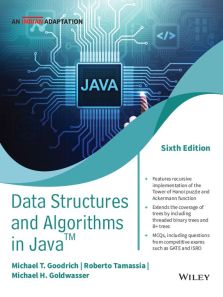Data Structures and Algorithms in Java, 6ed (An Indian Adaptation)
ISBN: 9789354247934
For more information write to us at: acadmktg@wiley.com

Description
Data Structures and Algorithms in Java offers a comprehensive, definitive introduction to data structures and algorithms, including their design, analysis, and implementation in Java. The contents of the book are organized to provide a pedagogical path that starts with the basics of Java programming and object-oriented design and foundational techniques such as algorithm analysis and recursion. The book then presents fundamental data structures, such as arrays, linked lists, stacks, queues, trees, heaps, maps, hash tables, search trees, and graphs, concluding with a discussion on searching and sorting algorithms and memory management. The book incorporates a host of pedagogical features, including illustrations, code fragments, and end-of-chapter exercises.
1 Introduction to Java
1.1 Preliminaries
1.2 Objects and Classes
1.3 Special Types
1.4 Java Expressions
1.5 Control Flow
1.6 Input and Output
1.7 Java Packages
1.8 Writing a Java Program
2 Object-Oriented Programming
2.1 Goals, Principles, and Patterns
2.2 Inheritance
2.3 Interfaces and Abstract Classes
2.4 Exception
2.5 Casting and Generics
2.6 Nested Classes
3 Introduction to Data Structures and Algorithms
3.1 Data Structures
3.2 Empirical Analysis
3.2.1 Moving Beyond Experimental Analysis
3.3 Common Mathematical Functions
3.4 Asymptotic Notations
4 Arrays and Linked Lists
4.1 Practical Uses of Arrays
4.2 Singly Linked Lists
4.3 Circularly Linked Lists
4.4 Doubly Linked Lists
4.5 Testing for Equality
4.6 Copying Data Structures
5 Recursion
5.1 Foundations of Recursion
5.2 Recursive Analysis
5.3 Applications of Recursion
5.4 Using Recursion
5.5 Pitfalls of Recursion
6 Stacks and Queues
6.1 Stacks
6.2 Queues
6.3 Double-Ended Queues
7 List Abstractions
7.1 The List ADT
7.2 Array-Based Lists
7.3 Position-Based Lists
7.4 Iterators
7.5 The Collections Framework
8 Trees
8.1 Trees Definitions and Properties
8.2 Binary Trees
8.3 Tree Representations
8.4 Tree Traversal Algorithms
9 Priority Queues and Heaps
9.1 The Priority Queue Abstract Data Type
9.2 Implementing a Priority Queue
9.3 Heaps
9.4 Sorting with a Priority Queue
9.5 Adaptable Priority Queues
10 Maps, Hash Tables, and Skip Lists
10.1 The Map Abstract Data Type
10.2 Hashing
10.3 The Sorted Map Abstract Data Type
10.4 Skip Lists
10.5 Sets, Multisets, and Multimaps
11 Search Trees
11.1 Binary Search Trees
11.2 Balanced Search Trees
11.3 AVL Trees
11.4 (2, 4) Trees
11.5 Red-Black Trees
11.6 Splay Trees
12 Graphs
12.1 Graphs
12.2 Data Structures for Graphs
12.3 Graph Traversals
12.4 Transitive Closure
12.5 Directed Acyclic Graphs
12.6 Shortest Paths
12.7 Minimum Spanning Trees
13 Strings and Dynamic Programming
13.1 Preliminaries
13.2 Pattern-Matching Algorithms
13.3 Tries
13.4 Text Compression and the Greedy Method
13.5 Dynamic Programming
14 Sorting and Selection
14.1 Merge-Sort
14.2 Quick-Sort
14.3 Studying Sorting through an Algorithmic Lens
14.4 Comparing Sorting Algorithms
14.5 Selection
15 Additional Topics
15.1 Memory Management
15.2 Memory Hierarchies and Caching
15.3 External Searching and B-Trees
15.4 Binomial Heap
15.5 External-Memory Sorting
15.6 Range Trees
Exercises
Multiple Choice Questions
Chapter Notes
Answer Key
Appendix A: Useful Mathematical Facts
Bibliography
Index

